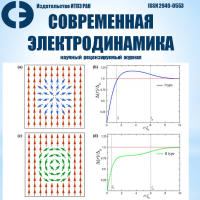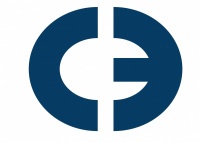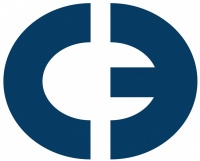
Section 1. Topics on experimental electrodynamics
Mathematical modeling of characteristics of electromagnetic field in tapered anechoic chambers
Balabukha N. P., Menshikh N. L., Sakhno A. D., Shapkina N.E.
Two types of tapered anechoic chambers are analyzed by mathematical modeling: conical and pyramidal, which are often used in measurements at low frequencies. For the comparison to be meaningful, the chambers need to be somewhat equivalent. In the work, equivalence is achieved by choosing the same flare angles and aperture areas of anechoic chambers. The radio-absorbing material of the inner surface of both chambers is modeled by a uniform dielectric layer. The characteristics of the field in the quiet zone in both chambers are compared when using a lens. Lenses in both cases are hyperbolic, have the same diameter and material parameters, and are installed in the aperture of the tapered part of the chamber. In this case, for each lens, the optimal focal length was selected, which made it possible to correct the phase to the maximum extent. The electromagnetic field inside the tapered chambers is calculated by the method of moments using the FEKO software package. The simulation results showed that both chambers have similar quiet zone sizes at the selected frequencies. The diameter of the quiet zone in the chambers with a lens was about 3 m. In both cases, the lens corrects the phase very well, but increases the uneven distribution of the field amplitude.
Key words: anechoic chamber, lens, lens collimator, tapered anechoic chambers, conical anechoic chamber, pyramidal anechoic chamber
EFFECT OF RE-REFLECTIONS BETWEEN A LENS AND AN OBJECT ON THE ACCURACY OF MEASURING ITS RCS IN A TAPERED ANECHOIC CHAMBER
Balabukha N. P., Menshikh N. L., Solosin V. S.
The article is devoted to the numerical study of one of the most important characteristics of the measuring facility - the error in measuring the RCS of an object. A low-frequency measuring facility based on an anechoic tapered chamber with a lens is investigated. Modeling of the characteristics of this facility was carried out earlier by the method of moments in the FEKO program. This article discusses the simulation of measuring the RCS of a disk in a tapered anechoic chamber with a lens. A comparison was made of the "measurement"of the RCS of the disk when using a lens with and without matching layer. For normalization, the same disk was considered as a reference object. It was done specifically in order to maximally compensate for errors in measuring the RCS of the disk associated with the nonuniformity distribution of the field in the quiet zone of the chamber. Thus, in the case under consideration, the main factor causing errors in measuring the RCS of an object is the presence of re-reflection between the disk and the lens. The results of the study showed that a coated lens can significantly reduce the error in determining the RCS of an object, moreover, in the frequency band, and not only at the frequency of matching. At a matching frequency of 600 MHz, the coated lens provides a significant increase in the accuracy of measuring the RCS of an object in the frequency band of 400-800 MHz.
Key words: tapered anechoic chamber, microwave range, radar cross-section, method of moments, simulations of measurements
Field experiments to substantiate the conditions of adjusting the radiation patterns of the radiator and receiver for studying of the deformation of ultra-wide-band subnanosecond pulses in the atmosphere at distances of ten kilometers or more
Bukin V. V., Dolmatov T. V., Efanov M. V., Lebedev E. F., Ostashev V. E., Ulianov A. V., Fedorov V. M., Shurupov M. A.
Field experiments have been carried out to substantiate the permissible mismatch angles of the radiation patterns of the emitter antennas and the receiver. These data are needed when direct experiments on the deformation of ultra-wide-band subnanosecond signals at distances of tens of kilometers in an atmosphere free from the influence of the Earth's surface will be conducted. The set values of the permissible mismatch angles up to 5 degrees, as well as data on the positions of interference signals reflected from the ground, make it possible to make the necessary design and organizational solutions.
Key words: ultra-wideband pulses, propagation through atmosphere, reflected signal influence Founding source
EFFECT OF TEMPERATURE ON MICROWAVE PERMEABILITY SPECTRUM OF COMPOSITE WITH GADOLINIUM POWDER
Starostenko S. N., Petrov D. A., Shiryaev A. O.
The constitutive parameters of a paraffin bound composite filled with 30% vol. of gadolinium powder are measured within the frequency range from 0.01 to 15 GHz and the temperature range from ~ 0°C go 35°C. The permittivity is constant within the measured ranges. Curie temperature of the composite is close to 15.5°C, the phase transition is shown to take place within a temperature range about 15.5°C ±10°. Constitutive parameters of the composite are measured in cooled coaxial lines applying reflection-transmission technique and additionally permeability is measured at the frequency below 100MH applying short-circuit technique. The temperature dependence of quasistatic permeability obtained by extrapolation to zero frequency is in agreement with the values retrieved from the published magnetization curves measured in temperature range. The effect of temperature deviation from Curie point on reflection and transmission of the composite is studied experimentally and via simulation. The effect of temperature is described in frame of cluster magnetization model based on Wiener mixing formula. The model is applied to design a microwave screen with variable attenuation, the attenuation of 4.5 mm-thick screen increases from about -2 dB to -20 dB at 3.5 GHz if the temperature decreases from 25°C go 5°C.
Key words: microwave permeability, Curie temperature, cluster magnetization, mixing model, tunable screen
Section 3. Topics on computer simulation in electrodynamics
DIMENSIONAL EFFECT IN CONCEALMENT WITH PYRAMYD-SHAPED ABSORBERS
Lebedev A. M., Semenenko V. N., Furmanova T. A., Krasnolobov I. I.
A pyramid-shaped absorber made of porous material with losses is widely used for radar concealment of structural elements in measuring of object's scattering characteristics. Dimensional effect manifests itself as a much smaller reduction of scattering from the surface as a result of masking it through the absorber application, than that would be the case for a surface of much larger sizes. So the effect determines the lower limit of the masked surface dimension interval, in which the efficiency of the absorber usage is maintained. The task to weaken the manifestation of the dimensional effect for a pyramidal absorber is most relevant in the low-frequency part of the radar frequency band (decimeter, meter waves), where effective masking of many rather big surfaces cannot be performed due to the dimensional effect. Using electrodynamic models, characteristic situation of the dimensional effect manifestation in case of a meter order wavelength was numerically investigated: the masked surface had dimensions of the wavelength order, the side of the absorbing pyramid's base was much smaller than wavelength, the pyramid's height was a fraction of wavelength, and the tangent of dielectric losses of the pyramid's material was up to values of order one or more. Influence of the dimensional effect on the backscattering radar cross section of square and round metal plates, masked with the pyramid-shaped absorber, in normal to the plate's surface direction was investigated. The conclusion was made that the main reason for the increased manifestation of the dimensional effect for the pyramid-shaped absorber, when compared with the absorber of constant thickness, is the diffraction effect due to incomplete averaging of contributions from separately taken pyramids into the scattered field. The research resulted in identification of two ways to lower the threshold of the dimensional effect manifestation for the pyramid-shaped absorber: reducing the size of the pyramid's base and insertion of a magnetic sublayer into the absorber.
Key words: pyramid-shaped absorber, dimensional effect, lower limit of the interval, diffraction effect, pyramid's base, magnetic sublayer
Section 3. Topics on interaction of an electromagnetic field with materials
Spinvortices and Majorana fermions in doped topological insulators with nematic superconductivity
Akzyanov R. S., Kapranov A. V., Rakhmanov A. L.
So-called topological superconductors exhibit many unusual properties that are of interest for applications in spintronics and quantum computing. In particular, the existence of Majorana fermion-type excitations was predicted and experimentally confirmed in these materials. In our work, we proposed one of the possible ways to create Majorana fermions in topological superconductors. As a specific system in which topological superconductivity is realized, we considered doped topological insulators of the type AxBi2Se(Te)3 (where A = Cu, Sr, Ba, ...). Based on these materials, high-quality single crystals have already been created, in which the existence of topological superconductivity with a vector nematic order parameter has been reliably established. Using the Ginzburg-Landau approach, we have shown that the deformation of a topological nematic superconductor can generate a specific (nematic) vorticity. In the case of doped topological insulators, this vorticity forms a spin vortex.We have shown that the existence of two types of topologically different spin vortices is possible. The equations of the microscopic theory (the Bogolyubov-de Gennes equations generalized to the case of topological superconductivity) were used to study the electronic states in a nematic superconductor with spin vortices. It is found that, in the case of a type I vortex, zero-energy states are localized near the vortex core. These states can be identified as Majorana-Kramers pairs. In the case of a type II vortex, there are no localized states with zero energy.
Key words: topological insulator, superconductivity, spin vortex, Mojorana fermion, Ginzburg-Landau theory, Bogoliubov-de Genn equations

Editorial address: 13 b. 6, Izhorskaya st.,
This site respects your rights and maintains confidentiality when filling out, transmitting and storing your confidential information.
Placing an application on this site means your consent to the processing of data and the further transfer of your contact information to our company.
Personal data means information related to the subject of personal data, in particular the name, contact details (email address) and other data classified as personal data by Federal Law of July 27, 2006 No. 152-FZ “On Personal Data.”
The purpose of processing personal data is to inform about the services provided by our company.
